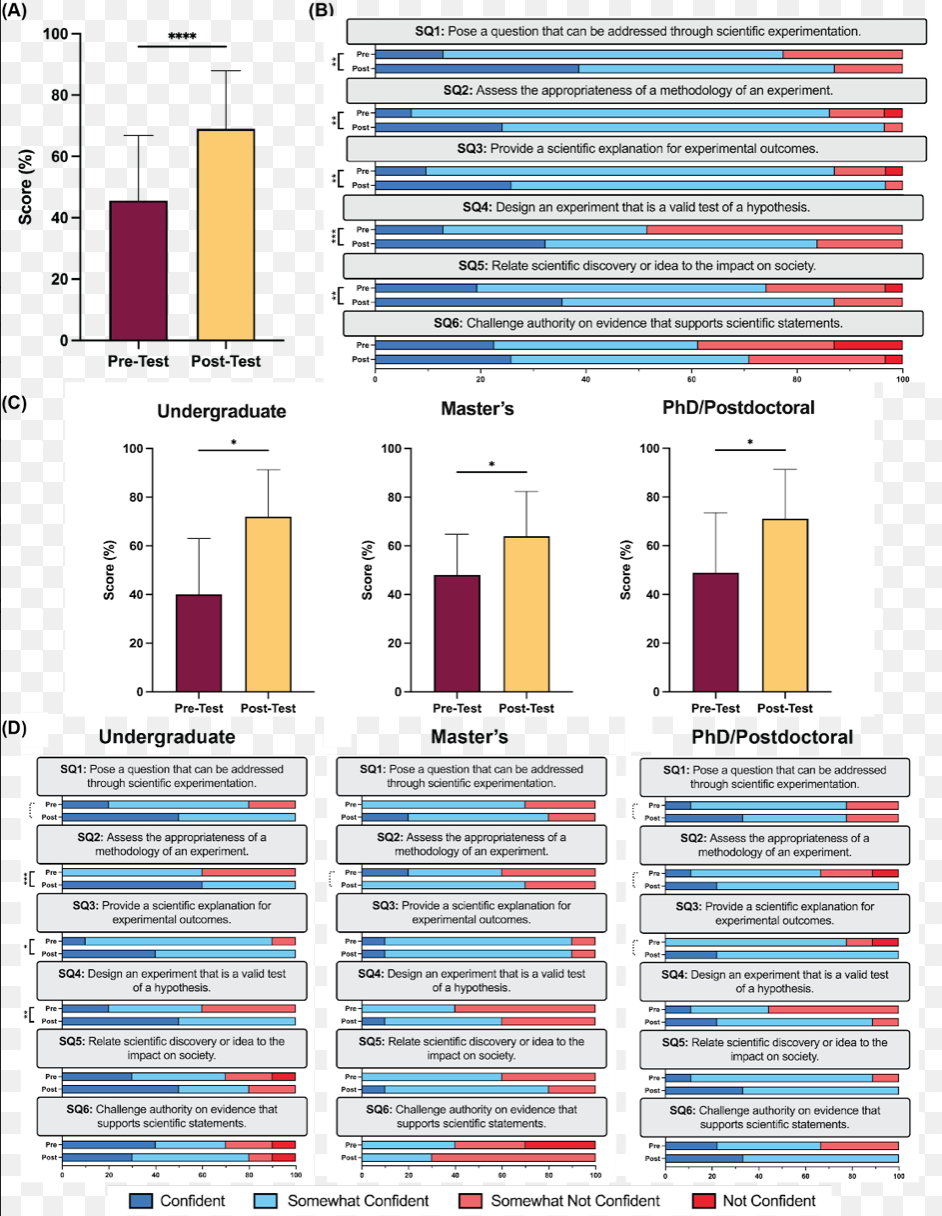(107g) Assessment of an Inquiry-Based Learning Bioadhesive Module to Teach Principles of Tissue Repair
AIChE Annual Meeting
2022
2022 Annual Meeting
Education Division
Assessment and Evaluation of Student Learning and Performance
Monday, November 14, 2022 - 2:20pm to 2:38pm
Methods: Instructors guided trainees through this 3 hr IBL module at The Cooper Union for the Advancement of Science and Art (undergraduate cohort), ETH Zürich (master’s cohort), and the Baltic Biomaterials Centre of Excellence (PhD/postdoctoral cohort). The first part of this module was a pre-laboratory exercise, which consisted of a brief background on bioadhesives and trainee-led discussions about experimental design. Next, trainees adhered two different substrates (i.e., chamois and 3D-printed polylactic acid (PLA)) together using two different bioadhesive (i.e., glutaraldehyde (GTA)-crosslinked gelatin and cyanoacrylate). GTA-crosslinked gelatin and cyanoacrylate were chosen as bioadhesives because they adhere through mechanical and chemical mechanisms, respectively, and because their components are commonly used for tissue repair applications [4]. Trainees tested the adhesive strength of their bioadhesives using a lap-shear configuration that mimics ASTM 2255-05, an internationally recognized protocol for testing the strength properties of tissue adhesives [5]. Briefly, trainees attached one side of their substrate to a digital luggage scale placed on top of a ring stand, then pulled the other side of their substrate to failure while recording the force reading with a smartphone. After completing this module, trainees completed a post-laboratory report or exercise, which introduced bioadhesives, described tested independent variables (e.g., GTA concentration, chamois vs. PLA), summarized results with appropriate statistical analyses and discussed findings in the context of tissue repair.
To assess the learning outcomes of these experiments, pre- and post-tests and pre- and post-surveys were given to each cohort. Pre/post-tests questions were designed by the authors to test trainee understanding of design variables and applications of bioadhesives for tissue repair. Pre/post-survey questions came from the Scientific Literacy and Student Value in Inquiry-guided Lab Survey (SLIGS) to assess scientific literacy [6]. A paired Student’s t-test (p < 0.05) was used to compare the average pre-/post-test and pre/post-survey scores. All questions were approved by The Cooper Union for the Advancment of Science and Art Institutional Review Board (IRB), the Ethics Commission of ETH Zürich, and the Baltic Biomaterials Centre of Excellence.
Results: Twenty-nine trainees (N=29) completed the pre/post-test assessment. Overall, pre/post-test results showed that trainees experienced highly significant learning gains from completing this IBL bioadhesives module (Figure 1A). Follow-up analyses of individual cohorts showed that undergraduate (N=10), master’s (N=9), and PhD/postdoctoral (N=10) cohorts all demonstrated equivalently significant learning gains (Figure 1C). While not significantly greater, the undergraduate cohort experienced the largest learning gains, with an average increase of 34.2 points.
Twenty-nine trainees (N=29) also completed the pre/post-survey assessment. Overall, results demonstrated that trainees were more confident posing scientific questions (SQ1), assessing methodology (SQ2), providing scientific explanations (SQ3), designing experiments (SQ4), and relating scientific discovery to societal impact (SQ5) as a result of completing this IBL bioadhesives module (Figure 1B). Similar to the pre/post-test assessments, follow-up analyses demonstrated that the undergraduate cohort (N=10) experienced the greatest improvements in scientific literacy (Figure 1D). Trainees in the master’s (N=9) and PhD/postdoctoral (N=10) cohorts only experienced trending increases in some categories of scientific literacy.
Discussion: This study designed, implemented, and evaluated an IBL bioadhesives module that effectively taught principles of bioadhesives to undergraduate, master’s, and PhD/postdoctoral trainees. This IBL bioadhesives module was implemented at multiple education levels because it was hypothesized that it could be effective for a broad range of trainees. For example, trainees in the undergraduate cohort experienced the greatest learning gains, which was expected since they would have had the least theoretical and applied knowledge of bioadhesives. Such learning gains are consistent with those in other published biomaterials experiments [7, 8]. More advanced trainees in the PhD/postdoctoral cohort also experienced significant learning gains by pre/post-test assessment. While PhD/postdoctoral trainees had more experience with scientific inquiry, their field of study materials science and chemical technologies and they had limited exposure to bioadhesive hydrogels. Therefore, this IBL bioadhesives study effectively introduced trainees in this cohort principles of bioadhesives, which they could incorporate into their primary area of research. These slightly reduced learning gains were consistent with biomedical engineering modules deployed on senior engineering students [8].
This IBL bioadhesives module also broadly enhanced trainee scientific literacy. The pre/post-survey used to assess scientific literacy employed validated survey questions to avoid self-reporting bias [9]. Notably, upon follow-up analyses, increases in scientific literacy were only significant for trainees in the undergraduate cohort. Trainees in the undergraduate cohort would have had the least exposure to scientific inquiry; thus, it is understandable that they would have had the greatest benefits. Moreover, since trainees in the master’s and PhD/postdoctoral cohorts had significant experience leading scientific investigations, it was expected that they would have less significant improvements in scientific literacy.
References:
[1] Biomaterials [Internet]. [cited 2022 Mar 11]. Available from: https://www.nibib.nih.gov/science-education/science-topics/biomaterials
[2] Tarafder S, Park GY, Felix J, Lee CH. Bioadhesives for musculoskeletal tissue regeneration. Acta Biomater. 2020 Nov;117:77–92.
[3]. Li J, Yu X, Martinez EE, Zhu J, Wang T, Shi S, et al. Emerging Biopolymer-Based Bioadhesives. Macromol Biosci. 2022 Feb;22(2):e2100340.
[4] DiStefano TJ, Shmukler JO, Danias G, Iatridis JC. The Functional Role of Interface Tissue Engineering in Annulus Fibrosus Repair: Bridging Mechanisms of Hydrogel Integration with Regenerative Outcomes. ACS Biomater Sci Eng. 2020 Dec 14;6(12):6556–86.
[5] Standard Test Method for Strength Properties of Tissue Adhesives in Lap-Shear by Tension Loading. ASTM International. 2005 Mar;
[6] Ankeny C, Stabenfeldt S. Cost-effective, Inquiry-guided Introductory Biomaterials Laboratory for Undergraduates. 2015 ASEE Annual Conference and Exposition Proceedings. ASEE Conferences; 2015. p. 26.412.1-26.412.16.
[7] Farrell S, Vernengo J. A challenge-based laboratory to explore drug delivery from swellable matrices. Education for Chemical Engineers. 2016 Oct;17:21–30.
[8] Vernengo J, Dahm KD. Two challenge-based laboratories for introducing undergraduate students to biomaterials. Education for Chemical Engineers. 2012 Jan;7(1):e14–21.
[9] Howard GS. Response-Shift Bias. Eval Rev. 1980 Feb;4(1):93–106.
